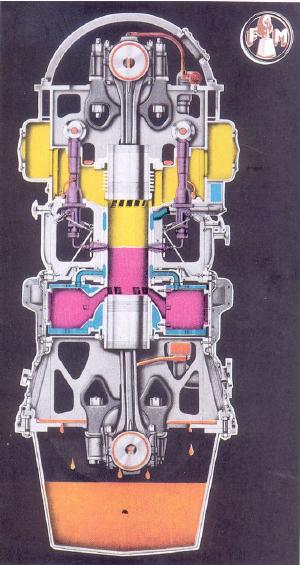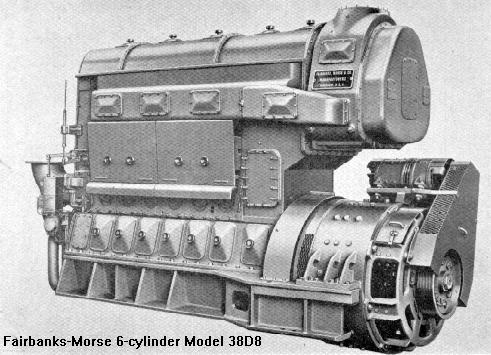Fairbanks-Morse 38D8 Diesel Engine
| Bore | Stroke | Pis. Disp. | Rated RPM | Cyl. scavenging |
|---|---|---|---|---|
| 8.125" | 10" | 518 cu. in. | 850 | Roots type blower |
 |
 |
 |
| Bore | Stroke | Pis. Disp. | Rated RPM | Cyl. scavenging |
|---|---|---|---|---|
| 8.125" | 10" | 518 cu. in. | 850 | Roots type blower |
 |
 |
 |
Right photo and text from "Diesel-Electric Locomotive", Foell and Thompson, 1946.
The underlying principle of the two-stroke cycle opposed-piston Diesel is the use of a plain open-ended cylinder in which combustion takes place in the center of its length between two pistons which move away from each other. The pistons are utilized to uncover the exhaust and air-inlet ports, thus eliminating the use of valves. The pistons controlling the air-inlet ports are connected to the upper crankshaft, while those controlling the exhaust ports are connected to the lower crankshaft. The two shafts are mechanically connected by a vertical shaft and bevel gears, with the lower shaft (exhaust end) being set 12 degrees ahead of the upper shaft (inlet end).
The cycle of operation begins with the movement of the pistons from their outer dead centers. After the pistons have covered the exhaust and intake ports, the air is compressed as the pistons continue to approach inner dead center. Fuel oil is injected at the proper time, ignition and combustion follow, and the resulting expansion forces the pistons outward on the power stroke, thereby delivering work to the upper and lower crankshafts.
Burning and expanding of the gases continue until near the end of the Power stroke, at which point the lower piston uncovers the exhaust ports to allow the burned gases to escape to the atmosphere. Slightly later in the cycle the upper piston uncovers the intake ports and air supplied by the blower rushes into the cylinder, cleans out all burned gases and at the same time produces a swirling motion in the scavenging air which continues throughout the compression stroke and injection period and contributes to the complete combustion of the fuel. This swirling motion of the scavenging air and its resulting sweeping of the cylinder is known as uniflow scavenging and is one of the principal factors contributing to the economy of the engine. The 12 degrees by which the exhaust piston "leads" the intake piston permits a more advantageous port timing, and also allows for a limited amount of "ram" effect which further contributes to the operating economy.
It is also obvious that when the upper piston is at inner dead center, the lower one has completed 12 degrees of its power stroke. This causes the lower piston to receive the greater part of the expansion work, at full engine load, with the result that about 72 percent of the total power is delivered by the lower crankshaft. The remaining power is delivered to the upper crankshaft where it is partially absorbed in driving the blower, leaving only a relatively small amount of power to be transmitted through the vertical gear drive to the lower crankshaft, which is connected to the driven machine.
The engine is a complete self-contained unit, with attached rotary-type blower, fuel and lubricating oil pumps and water pumps.